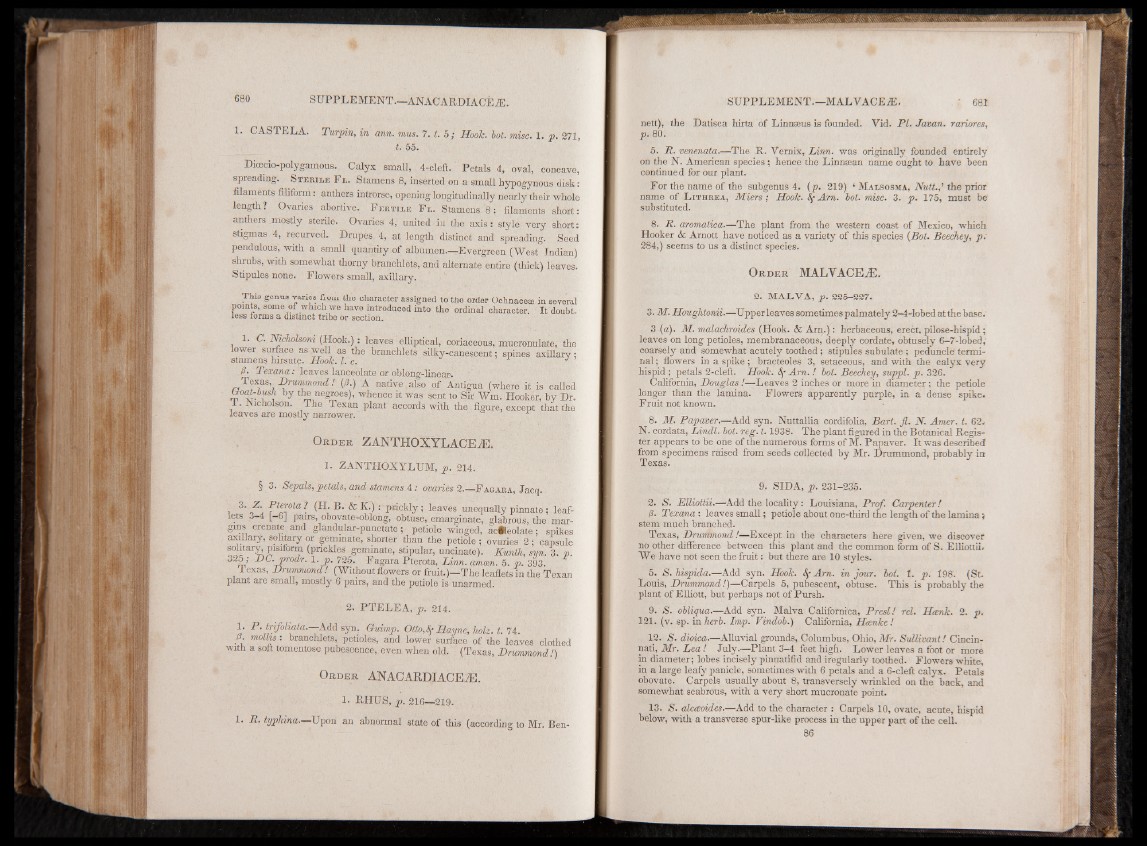
1. CASTELA. Turpin, in ann. mus. 7. t. 5 ; Hook. lot. misc. 1. p. 271,
t. 55.
Dioecio-polygamous. Calyx small, 4-cleft. Petals 4, oval, concave,
spreading. S teril e F l . Stamens 8, inserted on a small hypogynous disk:
filaments filiform: anthers introrse, opening longitudinally nearly their whole
length 1 Ovaries abortive. F e r t il e F l. Stamens '8 : filaments short:
anthers mostly sterile. Ovaries 4, united in the axis: style very short:
stigmas 4, recurved. Drupes. 4, at length distinct and spreading. Seed
pendulous, with a small quantity of albumen— Evergreen (West Indian)
shrubs, with somewhat thorny branehlets, and alternate entire (thick) leaves.
Stipules none. Flowers small, axillary.
This genus varies from the character assigned to the order Ochnacese in several
points, some of which we have introduced into the ordinal character. It doubtless
iorms a distinct tribe or section.
1. C. Nicholsoni (Hook.): leaves elliptical, coriaceous, mucronulate, the
lower surface as well as the branehlets silky-canescent; spines axillary;
stamens hirsute. Hook. 1. c. ' J
(3. Texana .* leaves lanceolate or oblong-linear*.
Texas,, Drummond,! (/?.) A native’also of Antigua (where it is called
^oat-busk by the negroes), whence it was sent to Sir Wm. Hooker, by Dr.
1 . Nicholson. The Texan plant accords with the figure, except that the
leaves are mostly narrower. /
Or d e r ZANTHOXYLACEiE.
1. ZANTHOXYLUM, p. 214.
§ 3. Sepals, petals, and stamens 4: ovaries 2.—F agara, Jacq.
i 3’ * f o,™*8 1 &•'& K .): prickly; leaves unequally pinnate ; leaflets
3-4 [-6J pairs, oboyate-oblong, obtuse, emarginate, glabrous, the margins
crenate and glandular-punctate; petiole winged, acUeolate; spikes
axillary, solitary or geminate, shorter than the petiole; ovaries 2 ; capsule
solitary, pisiform (prickles geminate, stipular, uncinate). Kunth, syn. 3. p.
’ DC. prodr. 1. p. 725. Fagara Pterota, Linn, amcen. 5. p. 393.
Texas, Drummond! (Without flowers or fruit.)—The leaflets in the Texan
plant are small, mostly 6 pairs, and the petiole is-unarmed.
2. PTELEA, p. 214.
1. P . trifoliata. Add syn. Guimp. Otto,8^ Hayne, holz. t 74
?: ndlf ■ branehlets,, petioles, and lower surface of the leaves clothed
with a soft tomentose pubescence, even, when old. (Texas, Drummond!)
Or d e r ANACARDIACEiE.
1. RHUS, p. 216—219.
1. R. typhina—•Upon an abnormal state of this (according to Mr. Bennett),
the Datisca hirta of Linnaeus is founded. Yid. Pi. Javan, rariores,
p. 80.
5. R. venenata.—The R. Vernix, Linn, was originally founded entirely
on the N. American species; hence the Linnaean name ought to have been
continued for our plant.
For the name of the subgenus 4. (p. 219) ‘ Malsosma, Nutt.,' the prior
name of L ithrea, Miers; Hook. 8j-Am. lot. misc. 3. p. 175, must be
substituted.
8. R. aromatica.—The plant from the western coast of Mexico, which
Hooker & Arnott have noticed as a variety of this species (Rot. Beechey, p :
284,) seems to us a distinct species.
Or d e r MALYACEiE.
2. MALVA, p . 225-227.
3. M. Houglitonii.—Upper leaves sometimes palmately 2-4-Iobed at the base.
3 (a). M. malachroides (Hook. & Am .): herbaceous, erect, pilose-hispid;
leaves on long petioles, membranaceous, deeply cordate, obtusely 6-7-lobed,
coarsely and somewhat acutely toothed ; stipules subulate ; peduncle terminal;
flowers in a spike ; bracteoles 3, setaceous, and with the calyx very
hispid ; petals 2-cleft. Hook. Am. ! lot. Beechey, suppl. p. 326.
California, Douglas !—Leaves 2 inches or more in diameter; the petiole
longer than the lamina. Flowers apparently purple, in a dense spike.
Fruit not known.
8. M. Papaver.—Add syn. Nuttallia cordifolia, Bart. fl. N. Amer. t. 62.
N. cordata, Lindl. lot. reg. 1.1938. The plant figured in the Botanical Register
appears to be one of the numerous forms of M. Papaver. It was described
from specimens raised from seeds collected by Mr. Drummond, probably in
Texas.
9. SIDA, p. 231-235.
2. S. Elliottii.—Add the locality: Louisiana, Prof. Carpenter!
0. Texana : leaves small; petiole about one-third the length of the lamina;
stem much branched.
Texas, Drurdmond!—Except in the characters here given, we discover
no other difference between this plant and the common form of S. Elliottii.
We have not seen the fruit: but there are 10 styles.
5. S. hispida.—Add syn. Hook. Sf Am . in jour. hot. 1. p. 198. (St.
Louis, Drummond!)—Carpels 5, pubescent, obtuse. This is probably the
plant of Elliott, but perhaps not of Pursh.
9. S. olliqua.—Add syn. Malva Califomica, Preslf rel. Hank. 2. p.
121. (v. sp. in herb. Imp. Vindob.) California, Heenke!
12. S. dioica.—Alluvial grounds, Columbus, Ohio, Afr. Sullivant! Cincinnati,
Mr. Lea ! July.—Plant 3-4 feet high. Lower leaves a foot or more
in diameter; lobes incisely pinnatifid and iregularly toothed. Flowers white,
in a large leafy panicle, sometimes with 6 petals and a 6-cleft calyx. Petals
obovate. Carpels usually about 8, transversely wrinkled on the back, and
somewhat scabrous, with a very short mucronate point.
13. S. alcceoides.—Add to the character : Carpels 10, ovate, acute, hispid
below, with a transverse spur-like process in the upper part of the cell.